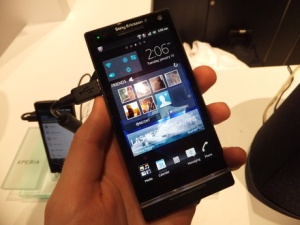Sony Xperia GPS adds Russian GLONASS satellites

Some new Sony Ericsson Xperia handsets can now use the Russian satellite positioning system GLONASS, in addition to the standard US-run GPS, increasing the likelihood of more accurate position reports.

Newer Sony Ericsson Xperia handsets, such as the Xperia S (above) are now able to use the Russian positioning system GLONASS, as well as GPS. Image credit: CNET UK
The combination satellite location service is only currently available on new Xperia handsets — such as the Xperia S and Ion — or any Xperia running on a Qualcomm S2 or S3 processor. The company announced the extended capabilities in a post on its developer blog on Thursday.
"In order for a phone to calculate a good position, a clear line of access to four or more satellites is needed. If the signals have bounced off a wall before reaching the receiver, it will reduce the accuracy of the position. This is where GLONASS, another version of satellite-based positioning system, can help," Magnus Persson, positioning specialist at Sony Ericsson, said in the post.
GLONASS, which stands for Global'naya Navigatsionnaya Sputnikovaya Sistema, is the Russian equivalent of the US's Global Positioning System (GPS) widely used throughout the world.
More accurate location information
Compatible devices will already have started using the GLONASS system alongside GPS in order to provide more accurate location information. The GPS standard is served by 31 satellites whereas GLONASS has a constellation of 24, nearly doubling the chances of the receiver being able to get useful data from a satellite.
"It's simple math — by supporting both systems in a receiver, the number of available global satellites increases from 31 to 55," Persson said. "Therefore, more geographic locations are able to receive four or more signals from satellites, which in turn means more successful position calculations and also better accuracy of the calculated positions in challenging environments."
The company said that in private testing, using the two systems in combination provided accuracy improvements of up to 50 percent.
In order to maximise battery life, the GLONASS system will only be activated in areas where location services traditionally struggle, such as heavily populated urban areas with high-rise buildings.
The change is backwards compatible, meaning that it will already be supported by most apps developed following the LocationManager class guidelines.
In addition to the GPS and GLONASS systems, work is also underway on providing a European positioning system called Galileo. In October 2011, the first two satellites to make up Galileo were launched from a European Space Agency base in French Guiana. The next two Galileo satellites are due to be launched in summer 2012. China is also working on extending its own capabilities.
Get the latest technology news and analysis, blogs and reviews delivered directly to your inbox with ZDNet UK's newsletters.